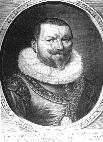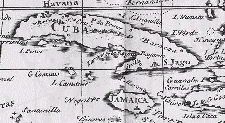

Piet Heyn learned the "art" of privateering during the years following the end of the twelve-year treaty (1621) with Habsburg, when many Dutch privateers were active against the privateers that operated from the Belgian city of Duinkerken. Heyn was amongst the Captains who distinguished themselves in that continuing struggle.
In 1623 he became Vice-Admiral in the service of the West Indies Company (WIC). One of the three main activities of the WIC was privateering, especially in the area of the West-Indies. Piet Heyn sailed with the first fleet of the WIC that was active in a privateering capacity and which consisted of 26 ships. They were despatched to Bahia (San Salvador) on the coast of Brasil in December 1623. The city was heavily bombarded for an entire day without much effect. Heyn sent 60 men in small ships to capture the ships that were moored in the harbour of Bahia. After capturing these ships a further 14 ships were sent, under the direct command of Heyn, to attack the walled city itself. When part of the walls was taken a larger party of men was sent to capture the entire city which fell soon afterwards without too much resistance. During the occupation of Bahia several Portuguese ships sailed unsuspecting into the harbour and were subsequently taken. 4 Dutch ships were sent home with prizes that consisted of sugar, tobacco and animal skins.
Piet Heyn left San Salvador on the 5th of August 1624 with seven ships for Sao Paulo de Loanda in Angola. He was ordered to capture this Portuguese city by the WIC. Loanda was an important city that was used for selling and transporting Africans that were captured. Heyn met 3 ships that were under the command of Filips van Zuylen. This squadron had tried to capture the city earlier but had failed and waited for the reinforcements from Brasil. In October 1624 Heyn arrived south of Loanda, missing the squadron of van Zuylen that was waiting to the north of Loanda. He decided to attack Loanda on his own, but failed miserably. His ships got repeatedly stuck in the shallows just outside Loanda and were, during their attempts to free them, easy targets for the enemy cannons. After trying to mobilize a local king of the African kingdom of Sonho who had earlier asked for assistance against the Portuguese he returned unsuccesful to Brasilian waters. When he arrived at Bahia he was confronted by the fleet of Don Fadrique de Toledo who had recaptured Bahia on April 30 of 1625. He decided to return to the Dutch Republic soon after their encounter.
In 1626 he received another commission in the service of the Dutch West India Company. Heyn captured several Spanish as well as Portugese ships in the years before he became famous for his capture of the Spanish Silver fleet. The Spanish ships sailing from the West Indies were frequently targets of French, Dutch and English privateers at that time. The routes these merchant ships took from Honduras and Mexico were well known by them.
After the successes in 1627 three privateer fleets were sent in 1628 by the WIC. After numerous battles, and having captured several prizes one of the fleets, under command by Pieter Adriaanszoon Ita, sailed for home.
 Soon after they left their leaving was known by the Spaniards. They now
thought that the main part of the Dutch privateering ships had left and
that they could safely depart with their ships, laden with silver,
without extra security. Unbeknownst to them, however, Piet Heyn had
arrived with a large privateering fleet consisting of 31 heavily armed
ships. He had set sail on the 20th of May 1628 with a part of his fleet
and was joined en route by several more ships in September of that same
year. Just like Ita had done, Heyn waited with part of his fleet on the
northern coast of Cuba. After having spotted the Spanish fleet he sent
part of his fleet to the East to prevent an escape. Because the Dutch
ships were much faster than the heavily laden Spanish ships they were
able to prevent them also from sailing into the harbour of Havana. In
despait the Spanish fleet sailed into the bay of Matanzas (forty miles
east of Havana). The Dutch followed them into the the bay after which
the Spanish fleet surrendered without a fight.
Soon after they left their leaving was known by the Spaniards. They now
thought that the main part of the Dutch privateering ships had left and
that they could safely depart with their ships, laden with silver,
without extra security. Unbeknownst to them, however, Piet Heyn had
arrived with a large privateering fleet consisting of 31 heavily armed
ships. He had set sail on the 20th of May 1628 with a part of his fleet
and was joined en route by several more ships in September of that same
year. Just like Ita had done, Heyn waited with part of his fleet on the
northern coast of Cuba. After having spotted the Spanish fleet he sent
part of his fleet to the East to prevent an escape. Because the Dutch
ships were much faster than the heavily laden Spanish ships they were
able to prevent them also from sailing into the harbour of Havana. In
despait the Spanish fleet sailed into the bay of Matanzas (forty miles
east of Havana). The Dutch followed them into the the bay after which
the Spanish fleet surrendered without a fight.
On September 17 Heyn sailed home from the bay of Matanzas. Due to bad weather he arrived several months later at the end of 1628. The cargoe of the Spanish ships of the Silver fleet was estimated to be worth 12 million guilders. The selling and distribution of the captured silver produced numerous problems and were the reason why Piet Heyn resigned his commission of the WIC.
In 1629 Heyn became Lieutenant-Admiral in the navy and was active as a privateer with a Commission from Frederick Hendrik, Prince of Oranje, Count of Nassau. He was given an assignment to form a blockade at Duinkerken, a haven for many Spanish privateers, with the fleet under his command. In a battle with 10 privateers from Oostende, in the Schelde Canal he died that same year. During his life he had become very popular as a heroic figure and numerous items were made after his death that commemorate him and his capture of the Spanish Silver fleet.